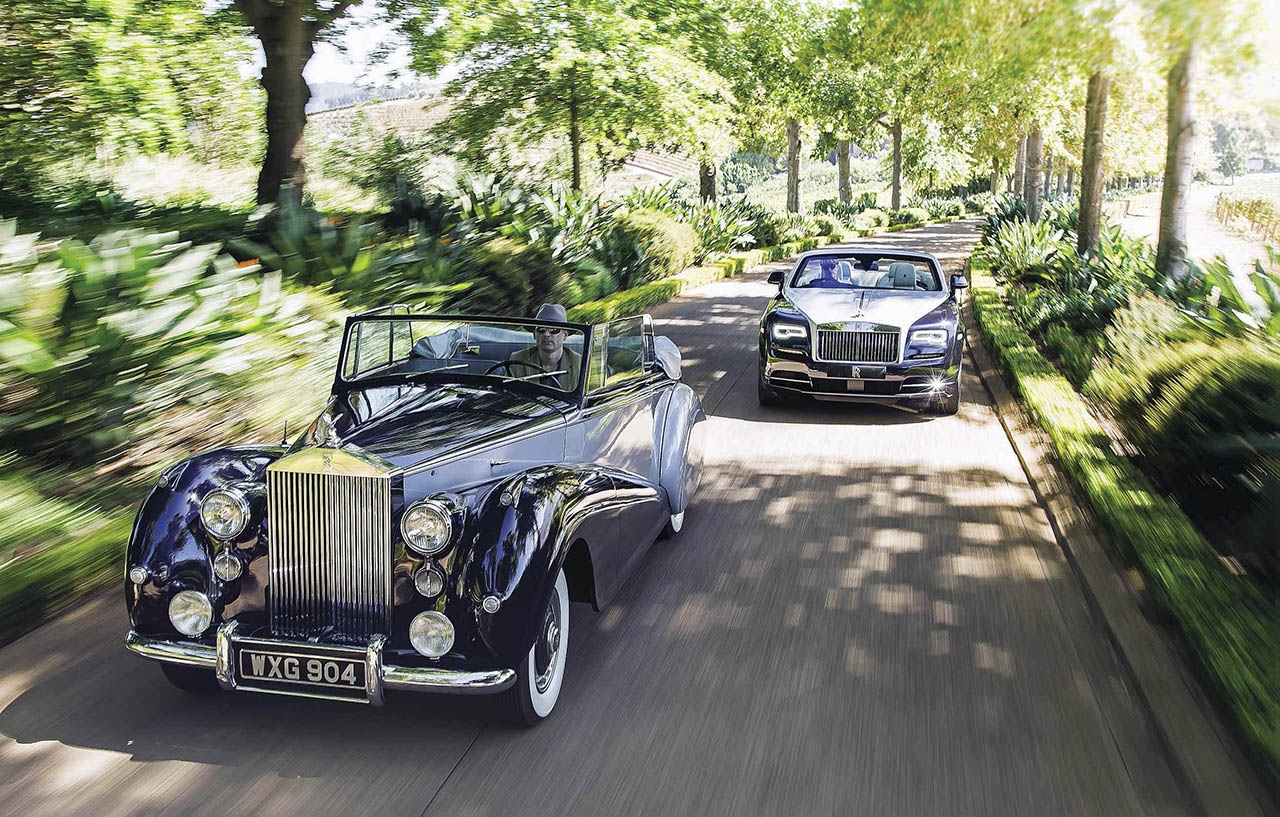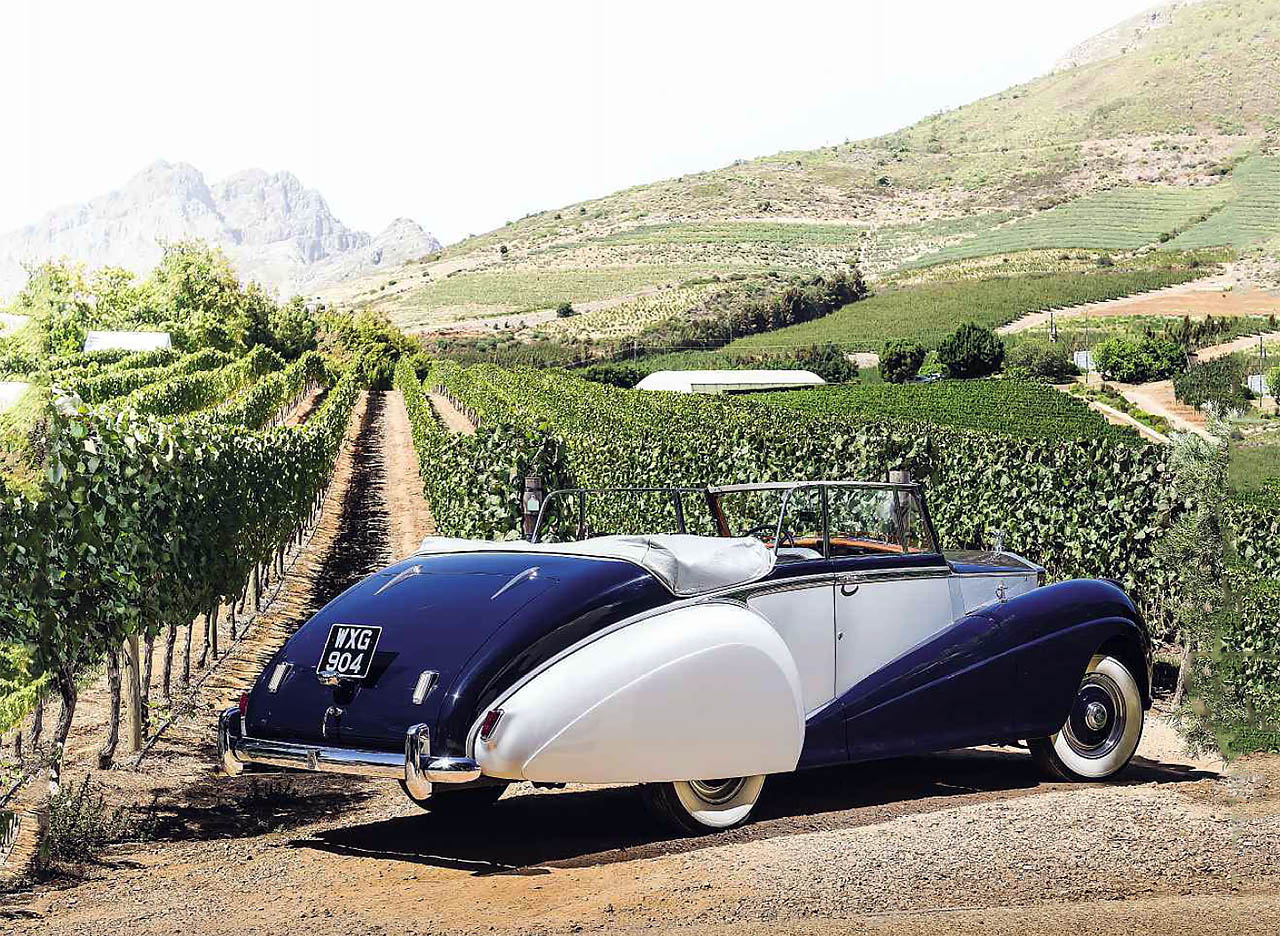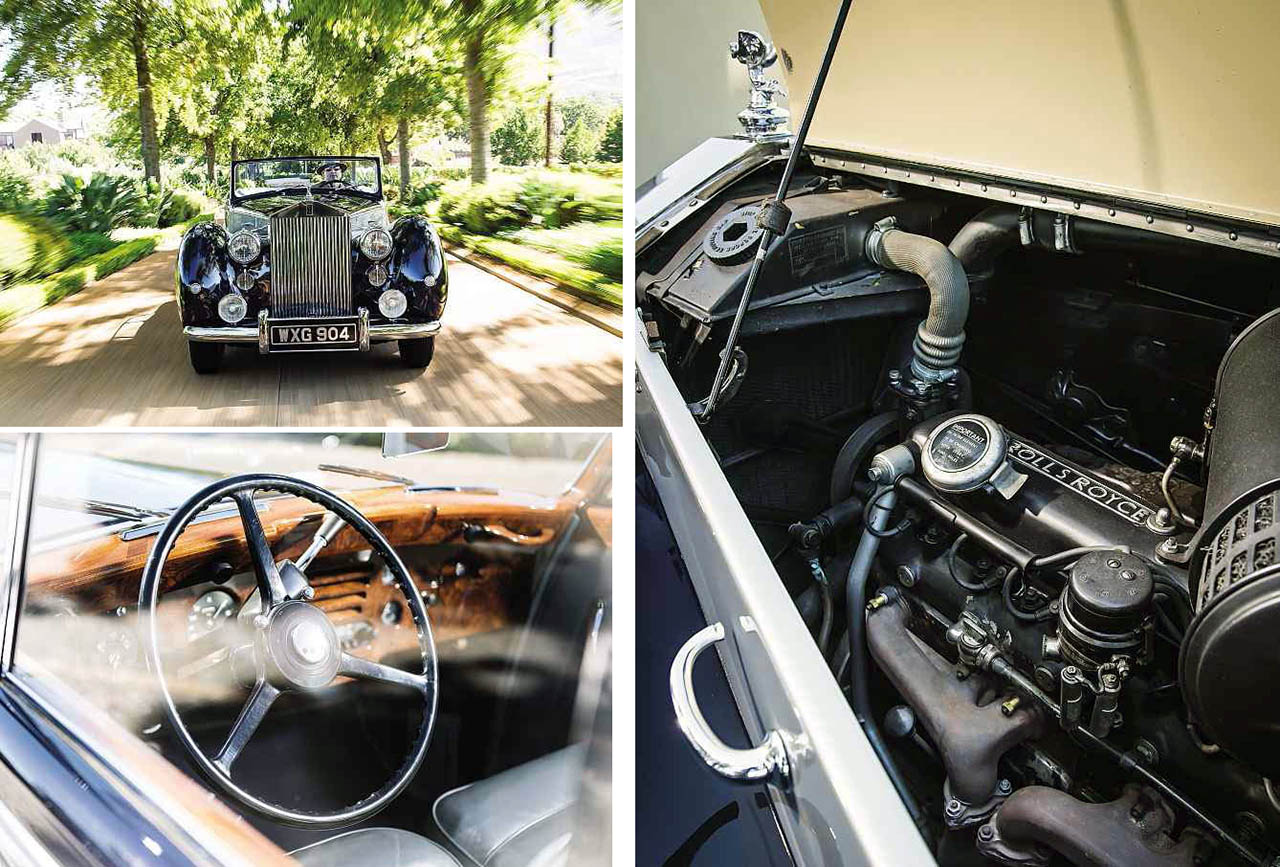
Rolls-Royce Dawn. New Rolls convertible – and the 1952 original. Dawn of a new era. Rolls-Royce’s new Dawn marries twin-turbo V12 pace with four-seater convertible luxury. How does it compare with the previous Dawn of more than 60 years earlier? Words Mark Dixon. Photography Jamie Lipman.
You wouldn’t usually describe a Rolls-Royce as sexy. Elegant, yes; luxurious, most definitely. But sexy? Well, that’s how the company would like you to perceive its new Dawn. Moodenhancing video played at the car’s launch intercut erotic images of a woman disrobing with shots of the Dawn’s hood raising and folding away. ‘Your mother wouldn’t like it,’ was the beautifully understated implication, ‘…but you sure as hell would.’

Facing page and below. All hail the new Dawn: it has the pace of a Ghost, the sexy styling of a Wraith and much of the presence of a Phantom Drophead Coupé – for two-thirds the price. It’s a Rolls-Royce for which the chauffeur’s services will not be required.
Actually, your dear old mum would absolutely love the Rolls-Royce Dawn. It’s a full four-seater convertible – room for all the family – and it is as beautifully and creatively trimmed as all the current Royces are. But it will also satisfy the petrolhead in you, being a two-door soft-top with a twin-turbo 6-litre V12 that goes like a hot rod – and looks like one when the hood’s erected. As the old saying goes, what’s not to like?
Apart from the price – £250,000 for the, er, basic model – very little, is the answer. The Dawn marries the running gear of the Wraith coupé with new styling by Rolls-Royce design director Giles Taylor (who, we’re pleased to report, owns a Series I Land Rover. The man is sound). It was inspired, so the suits claim, by a model from Rolls-Royce’s extensive back catalogue: the 1952 Silver Dawn, as bodied by Park Ward.
More cynical souls might wonder whether the choice of name came first, and the raiding of the brochure cupboard afterwards, but Rolls-Royce does own the older car pictured here. Company execs spotted it at a Pebble Beach auction in 2014 and cannily realised that it would be well worth acquiring for the company’s collection. It’s in fine condition, having remained in single ownership for nearly half a century and recently freshened up with new paint, soft trim and hood.
Back in the day, the Silver Dawn was a relatively humble machine by Rolls-Royce standards. It was driven by the need to rationalise and retrench in a post-war world that was very different from the decadence of the 1920s and ’30s. The standard Dawn saloon, as launched in 1949, had a pressedsteel body and a single-carb straight six. It was basically a Bentley MkVI with a Rolls-Royce grille and a slightly detuned engine. The reason for this ‘badge engineering’ was simple: Rolls-Royce needed to sell into the USA, but wealthy Americans weren’t going to pay Rolls-Royce money for something without that famous grille.

The Dawn was export-only at first, and it wasn’t until 1953 that it was even available in the UK. The Dawn was always a much rarer car than the MkVI, however, with just 761 built compared with 5200 Bentleys. Dropheads were extremely exclusive (so the new Dawn can claim kinship in that respect, at least), totalling only 28 examples, including six by Park Ward. Our feature car was delivered new to Rolls-Royce’s Canadian dealership, JL Cooke Motors of Toronto, on 16 July 1952. It was cherished by two owners in Canada before being sold to a Mr Roy G Wild in Ohio, USA, who would keep it for the next 46 years. Even then it couldn’t escape the gravitational pull of its earlier life, being returned to Canada for a total mechanical overhaul and engine rebuild.
Until Mr Wild’s death in 2008 it still wore its original paint and interior, but they were renewed in the years just before its Pebble Beach sale. Rolls-Royce flew this 1952 example, chassis LSHD60, out to South Africa for the international launch of the 2016 Dawn. Journos arriving at the beautiful Delaire Graff wine estate in Stellenbosch – OK, so this was never going to be an arduous assignment – would see it flanking the entrance with a matching new car, admire it briefly and then retire to the welcoming shade of the estate lodge. It’s there purely as an ornament and talking point. But we’re from Octane so, naturally, we’ve asked if we can drive the old car too.

Heave open the rear-hinged driver’s door and settle onto the broad front seat – it’s comfortable but flat as a piano stool, so just as well you have a big three-spoke steering wheel to hang onto (your passenger is treated to their own contoured wooden grab handle). In front of you is a sea of walnut that washes around the dashboard and streams along the door tops, anchored by a beautifully understated matt-black period radio. Maybe it’s no coincidence that its functional style is reminiscent of a WW2 aircraft’s instruments, of the kind with which many Rolls-Royce employees and customers would be all too familiar.
Twist the dainty ignition key and press the starter button. The Dawn’s 4566cc engine coughs discreetly into life with a delicious straight-six burble whose sportiness comes as something of a surprise – and as a reminder that this car shares its underpinnings with the Bentley MkVI, which in turn evolved into the notably fleet-of-foot R-Type Continental. Even fitted with a single Zenith carburettor rather than the twin SUs of the Bentley, the Dawn was good for 95mph, which was going some for a big limo of the early 1950s.
Mounted on the steering column is what looks like an old-fashioned selector for an automatic transmission but turns out to be a manual gearbox column ’change – a sweetener for those hoped-for US buyers who were more at home with a column ’change than a stick shift. This being a Rolls, however, it’s superbly engineered and has none of the sloppiness usually associated with these multiple-linkage devices.

So, into first and away; bottom gear is a stumppuller, as fitted to Royces since the dawn of time. The unassisted steering is on the heavy side, as expected, but as soon as you’re moving beyond a crawl it lightens up and has a deliciously creamy action. The realisation dawns (sorry) that this regal Royce is actually going to be enjoyable to drive. While that may sound like a terrible admission, the fact is that its severe Palladian grille makes the car look like something designed in the 1920s rather than the late ’40s. Whisper it softly, but the equivalent Bentleys, with their softly rounded radiators, do look more up-to-date.
Whether Bentley or Rolls-Royce, these cars were still built on hefty separate chassis, but there was independent suspension up front by coil and wishbone, so they handle well – remember all those MkVI Specials that were built in later years? This Dawn is a car that can still be driven up to modern speed limits, and beyond; as a luxury tourer it does the job it was designed for, almost 70 years ago. Yes, it doesn’t have the eery hush of a ‘modern’ when its slightly cumbersome hood is erected, and it’s not fast by any current definition. But for cruising top-down through the spectacular scenery of the Western Cape’s wine-growing region, it’s just perfect.
Imagine yourself outside the car for a moment, a humble 1952 pedestrian admiring this exotic creation from a distant land, and Park Ward’s artistry in transforming the plain-Jane standard saloon is striking. Aside from that patrician grille and the boxy triumvirate of windscreen and quarterlights, this could be a design from one of the great French coachbuilders such as Franay, its swooping lines accentuated by the fully enclosed rear wheels and the two-tone paint.
The car’s best view is surely from the rear threequarters, where the curves are barely interrupted by discreet slivers of lamp units. Even in early ’50s America, where automobile styling was exhibiting considerably more flair than in a Europe that was still shell-shocked, Park Ward’s design would have looked notably elegant.
Today’s Dawn is a very different kettle of fish. Like the 1952 car, it has a radiator that is resolutely old-fashioned in proportions and rectilinear shape – but because of that, rather than despite it, the car looks ageless rather than dated. Can you say, off the top of your head, when the current Phantom was launched? It was back in 2003, with the Ghost following in 2009, and yet both cars still look contemporary because they defiantly ignored the fashions of the day. In 2013 they were joined by the Wraith, a big two-door coupé with something of the Phantom’s presence but the power of the Ghost’s twin-turbo V12 – it always seemed an anomaly that the Phantom, flagship of the range, had a less powerful engine than the ‘entry level’ Ghost.

Above and facing page. Original Dawn looks a little staid from the front but voluptuous from behind, and has adequate pace from its single-carb 4.6-litre straight six – a detuned version of the engine found in the Bentley MkVI.
It’s fair to say that the Wraith’s styling wasn’t universally admired, some finding it rather heavy around the rear end, for all that its designer Giles Taylor readily admitted to having been inspired by great Italian GTs of the 1950s. No such criticisms can be levelled at the Dawn. Taylor and his team put a lot of effort into ensuring that, with hood erected, the Dawn has something of a cut-and-shut, high-waist, low-roof hot rod vibe to it, the plunging curve of the shallow side glasses repeated by the flattened arc of the roofline.
That hot rod vibe is emphasised by a small rear window that’s just big enough to give the driver adequate rearwards vision, and a bubble-roof profile that is a world away, conceptually, from the slightly severe character of the Phantom. Unfortunately, you’ll have to take our word on this. We never raised the roof during our photoshoot – I mean, why would you? Any Octane reader would surely insist on driving top-down unless rain were falling in Biblical proportions.
So, the new Dawn looks great with the top up, but it’s even better as the convertible it was designed to be. Our feature car is a relatively sober-looking example, chosen because its colour scheme mirrors that of the 1952 original, but the new Dawn has enough chutzpah to carry off the most lairy of shades on the Rolls-Royce colour chart. One of the press launch cars was finished in a vivid china blue; affectionately dubbed the ‘Cheesemobile’ by launch attendees, nevertheless it was always in demand for photography.
So, while you can opt for traditional polished burr wood trim if you are so inclined, why not push the boat out – an appropriate metaphor, as it happens – and go for the yacht-clubby theme pioneered by the Phantom Drophead Coupé? The optional open-grain Canadel wood (Canadel being a brand name, not an arboreal species) gives a more contemporary, laid-back feel, especially where it spreads over the upper surface of the tonneau cover like decking, and then pours down over hard trim. You don’t buy a convertible to look anonymous, after all.
So what does the Dawn do that the Phantom DHC doesn’t? It’s sleeker and, yes, sexier – Rolls- Royce’s soundbite for the Dawn is ‘strikingly seductive’ – and it’s slightly smaller, although these things are all relative, for the Dawn is still well over 17ft long. It’s also a lot brisker by virtue of its twin-turbo V12, even if it is in 563bhp Ghost rather than full-house 624bhp Wraith spec.
The Dawn will appeal to a younger audience than the patriarchal Phantom, hopes Rolls-Royce (the Dawn brochure is populated by 30-something men dressed in smart casuals and designer stubble, partnered by fashion-model yummy mummies who have presumably handed the toddlers over to nanny). And the Dawn costs less than two-thirds the price of the Phantom, a difference that even very rich people will notice.
It’s a great drive, too. It doesn’t feel ridiculously big from behind the wheel and you can really hustle it if you’re in the mood: mash the pedal into the (optional) lambswool overrug and you’ll hit 60mph in under five seconds. In such circumstances the V12 issues a discreet yet thrilling snarl – under normal conditions it is, of course, virtually inaudible – and the big Royce becomes a real driver’s machine. While the steering isn’t massively ‘feelsome’ (to use that word beloved of motoring journalists and no one else) it’s pleasantly weighted, thanks to speedsensitive variable power assistance, and the car turns in sharply and corners remarkably flatly on its air springs. Much fun can be had in confounding other road-users’ prejudices by driving in press-on mode rather than wafting along like a retired antiques dealer.
That said, the ride, while perfectly acceptable, can’t totally disguise the fact that this car weighs 2.5 tonnes and has to carry around a fair bit of unsprung weight (big 20 or 21in wheels, suspension) without feeling like a marshmallow. There’s an underlying firmness, an inability to soak up tiny imperfections, that people who exclusively drive modern cars might not even notice but which comes as a slight disappointment to anyone old enough to remember, say, a 1968 Jaguar XJ6. Unusually in this day of driverselectable suspension settings, Rolls-Royce resolutely refuses to offer the option. Nor do you get a revcounter, which we’d infinitely prefer to the gimmicky ‘Power Reserve’ indicator.
Keen drivers might also at least appreciate the option to override the eight-speed automatic gearbox – a pure auto’ feels almost retro, these days – but it has to be said that the GPS-aided gearchanges, which are guided by satellites reading the road ahead, are flawless. It’s a tribute to the Dawn’s fun factor that such an option could even be thought worth mentioning, but this is very much an owner-driver car.
If you get the impression that we’re clutching at straws in finding nits to pick, so to speak, then you’re absolutely right. Any criticisms are rendered meaningless in the wider context, which is the sheer joy of travelling in a Dawn. And it’s a joy that’s no longer tainted by the green-eyed envy that Royces might have attracted 30 or 40 years ago: the brand seems to have won new respect for representing the very best of British (even if it is owned by BMW). In the words of James Warren, Rolls-Royce’s unfailingly cheery PR man, who spends a lot of time behind the wheel of his company’s products, ‘It’s a long time since I was on the receiving end of a two-fingered salute. These days it’s all cameraphones and thumbs-ups.’
He’s right; to drive a Rolls-Royce these days seems to mark you out as a person of taste rather than simply one of wealth. That may be down to two factors: one, Great Britain plc has got some of its mojo back – and Daniel Craig has to take some of the credit for that – and two, today’s iPhone generation is design-literate enough to appreciate the distinctive style of a current Rolls-Royce.
Design, however, can never stand still and the writing is on the wall for the Phantom, which will bow out this year ahead of a brand-new model whose launch date has yet to be announced. That leaves the Ghost, Wraith and Dawn to serve Rolls- Royce’s customer niches. Rationalisation, in other words. Maybe the resurrection of the Dawn name is more appropriate than we first thought.
1952 Rolls-Royce Dawn Drophead Coupé by Park Ward
Engine 4566cc straight-six, overhead inlet and side exhaust valves, single Zenith DBVC42 carburettor
Power N/A
Torque N/A
Transmission Four-speed manual, rear-wheel drive
Steering Cam and roller
Suspension Front: coil springs, wishbones, hydraulic dampers, anti-roll bar. Rear: live axle, leaf springs, driveradjustable hydraulic dampers
Brakes Drums
Weight N/A
Performance Top speed 95mph (est)
2016 Rolls-Royce Dawn
Engine 6592cc all-alloy V12, 48 valves, direct injection
Power 563bhp @ 5250-6000rpm
Torque 575lb ft @ 1500-5000rpm
Transmission Eight-speed ZF 8HP90 automatic
Steering Hydraulic rack and pinion Suspension Front: air springs and wishbones, active roll bar.
Rear: air springs, multilink, active roll bar
Brakes Vented discs
Weight 2560kg
Performance Top speed 155mph. 0-60mph 4.9sec





